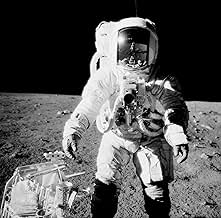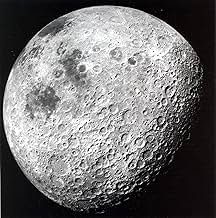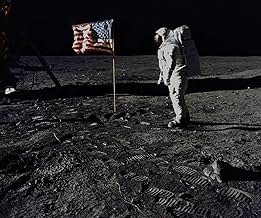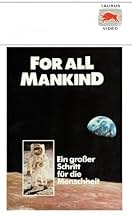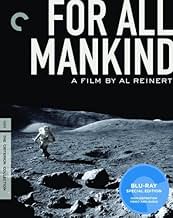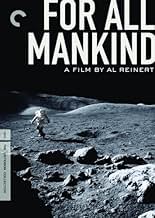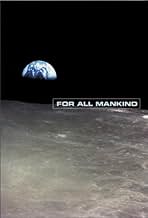IMDb RATING
8.1/10
6.9K
YOUR RATING
An in-depth look at various NASA moon landing missions, starting with Apollo 8.An in-depth look at various NASA moon landing missions, starting with Apollo 8.An in-depth look at various NASA moon landing missions, starting with Apollo 8.
- Nominated for 1 Oscar
- 3 wins & 3 nominations total
Jim Lovell
- Narrator - Apollo 8, Apollo 13
- (voice)
- (as James A. Lovell Jr.)
Ken Mattingly
- Narrator - Apollo 16
- (voice)
- (as T. Kenneth Mattingly II)
Russell Schweickart
- Narrator - Apollo 9
- (voice)
- (as Russell L. Schweickart)
Eugene Cernan
- Narrator - Apollo 10, Apollo 17
- (voice)
- (as Eugene A. Cernan)
Charles Conrad
- Narrator - Apollo 12
- (voice)
- (as Charles P. Conrad Jr.)
Richard Gordon
- Narrator - Apollo 12
- (voice)
- (as Richard F. Gordon Jr.)
Alan Bean
- Narrator - Apollo 12
- (voice)
- (as Alan L. Bean)
Jack Swigert
- Narrator - Apollo 13
- (voice)
- (as John L. Swigert Jr.)
Stuart Roosa
- Narrator - Apollo 14
- (voice)
- (as Stuart A. Roosa)
James Irwin
- Narrator - Apollo 15
- (voice)
- (as James B. Irwin)
Charles Duke
- Narrator - Apollo 16
- (voice)
- (as Charles M. Duke Jr.)
Harrison Schmitt
- Narrator - Apollo 17
- (voice)
- (as Harrison H. Schmitt)
Buzz Aldrin
- Self
- (archive footage)
Bill Anders
- Self
- (archive footage)
Neil Armstrong
- Self
- (archive footage)
Stephen Bales
- Self
- (archive footage)
- (as Steve Bales)
Frank Borman
- Self
- (archive footage)
Featured reviews
10bobbrown
Without repeating all the good comments that have been mentioned by earlier reviewers, I will add what is unique for me.
1. When Reinert wonderfully builds up the tension for the liftoff, it is more than a crescendo of power when those Saturn 5 rocket motors blast to life! I've had the film on VHS tape for about 10 years, and I still enjoy knocking the socks off of first time viewers when the surround sound system is allowed give its all as it shakes the house. If there were ice chunks on the outside of my house, they would surely shatter and fall just as they did from the rocket body as it slowly left the pad. UNBELIEVABLE! I once read that the Apollo rocket, if it all exploded at one time, would equal 80% of the Hiroshima atomic explosion in WW2. Imagine sitting atop that 31 story tall monster awaiting your fate on the launchpad.
2. Eno's music- just can't say enough superlatives about this soundtrack. Like good art, there is plenty there to continue to pique your interest for years. He is a gift to all mankind for his work on this soundtrack, but that is just the beginning. He's been doing that high level of work for decades!
GREAT FILM!!!
1. When Reinert wonderfully builds up the tension for the liftoff, it is more than a crescendo of power when those Saturn 5 rocket motors blast to life! I've had the film on VHS tape for about 10 years, and I still enjoy knocking the socks off of first time viewers when the surround sound system is allowed give its all as it shakes the house. If there were ice chunks on the outside of my house, they would surely shatter and fall just as they did from the rocket body as it slowly left the pad. UNBELIEVABLE! I once read that the Apollo rocket, if it all exploded at one time, would equal 80% of the Hiroshima atomic explosion in WW2. Imagine sitting atop that 31 story tall monster awaiting your fate on the launchpad.
2. Eno's music- just can't say enough superlatives about this soundtrack. Like good art, there is plenty there to continue to pique your interest for years. He is a gift to all mankind for his work on this soundtrack, but that is just the beginning. He's been doing that high level of work for decades!
GREAT FILM!!!
I won't reiterate all of the praise of this film except to say that if I had just few more spare dollars when it was released on laserdisc, I would have bought a laserdisc player just for this title (and 2001). Fortunately years later I've already purchased a DVD player and For All Mankind has finally been released on that format.
To me the defining moment of this film is the lunar lander slowly returning to the command module. At first we only see the cratered surface of the Moon moving below at incredible speed. Then we see a tiny motionless speck above it. Was it a defect in the lens? Of course not. It's the lunar lander slowly returning from the surface. It seems to take much longer than it really does because there are no cuts and no narrator explaining what we already know we're seeing. There's only a dot turning into a space ship. What more could you add to this amazing sight?
To me the defining moment of this film is the lunar lander slowly returning to the command module. At first we only see the cratered surface of the Moon moving below at incredible speed. Then we see a tiny motionless speck above it. Was it a defect in the lens? Of course not. It's the lunar lander slowly returning from the surface. It seems to take much longer than it really does because there are no cuts and no narrator explaining what we already know we're seeing. There's only a dot turning into a space ship. What more could you add to this amazing sight?
In a project almost more ambitious than the Apollo program itself, Al Reinert distills six million feet of NASA film footage and over 80 hours of taped interviews into a glorious 90- minute flashback to the ultimate achievement of our time: the manned exploration of another world. The film condenses all ten Apollo moon shots into a single flight, using only the genuine sights, sounds, and impressions experienced by the astronauts themselves along the way, from the tension and exhilaration of lift off to the joy (and inconvenience) of zero gravity, and from the loneliness of deep space to the wonder of stepping foot on an alien world. Seeing the footage for the first time on a big screen can be a revelation; it's a thrilling, vicarious journey across a new threshold in human evolution, providing both an argument for the continued human exploration of the cosmos and a timely reminder of how precious life on our own planet is.
Most of this NASA footage is not what you've been able to see on the news but footage that shows more of the humanity and introspective moments that happen in the midst of the spectacular. Extended moments of them approaching the moon before the Eagle lands and the astronauts describing what it's like walking on the moon and as they explore and try to take a moment stop and simply ponder being on the Moon. A must see for any space fan.
This film is a retelling of arguably one of the greatest achievements of the human race. In summer 1969, on a bright sunny morning, a group of astronauts led by commander Neil Armstrong climbed into the Saturn V rocket ready for its first flight. Not even 70 years had passed since planes had been invented. About 1 million people had gathered at the Kennedy Space Center in Florida to witness the once in a lifetime event, and millions more watched the entire thing on television. This film attempts to recapture some of that excitement that must have been everywhere on that day. It features interviews with the people who were brave enough to leave Earth in order to visit a place that has always watched over humanity, quite literally. At some points, it feels almost like a horror movie because nobody in the rocket or back on Earth knew if the thing would just blow up in flight for no reason, and the inside of the rocket module looks incredibly small. One of the astronauts says how strange of an experience it was and how going to the moon isn't like travelling to any other place, because when you travel somewhere, you have various landmarks to tell how far you got. On the moon mission, he says you leave Earth, pass an unimaginably large area of absolutely nothing for a few days, and suddenly, you're at the moon. There is nothing in between. The fact that the moon is only about a quarter of a million miles from Earth while stars are so far away you couldn't reach them even if you travelled your whole life makes it even more daunting. After the module lands on the surface, Neil says his famous line, and we see more very impressive shots of what the surface of the moon looks like. It has a depressing feel to it because the only colors are gray and black, but at the same time, it has a triumphant feel. The moon has been waiting thousands of years for people to go there, and the men reflect this by saying even though they knew they might not come back, they felt at home there. The soundtrack for this movie also gives it a sad feel that makes you realize how vast and empty space is. They show many things that seem unbelievable, even to experienced astronauts, such as small dots of light on the African continent (they're actually fires started by tribes), and having their food float in zero gravity when they're trying to eat. This is something that everyone should see at least once, because it discusses one of humanity's biggest accomplishments. To this day it's strange to think it was done in the 60s. Not many people have been to space, so you will be amazed watching this.
Did you know
- TriviaThe staging footage was captured because NASA wanted to document the flight process of an unmanned Saturn flight for feedback in case there was a failure for engineers to look at footage to see what went wrong. Cameras were mounted in strategic locations, kicking on at critical moments to document the staging process for less than half a minute. After completion, the light-tight canisters containing the exposed film were jettisoned, dropping to earth with homing beacons and parachutes inside protective heat shields. Air Force C-130 transport planes, towing gigantic nets, recovered the canisters in the southern Atlantic Ocean.
- GoofsThe opening of the documentary incorrectly states that: "During the four year between December 1968 and November 1972, there were nine manned flights to the moon." The last lunar mission, Apollo 17, took place in December 1972.
- Quotes
Charles M. Duke Jr.: The only bad part about zero gravity in Apollo was goin' to the bathroom. We had a very crude system. For your feces it was a bag, and you put this bag in the right position. So you go, but the only thing is that nothing goes to the bottom of the bag in zero gravity.
- Crazy creditsFilmed on location by the United States National Aeronautics and Space Administration.
- SoundtracksSirens
Courtesy of Opal Records (Music For Films III)
Written and Performed by Daniel Lanois and Brian Eno
Licensed by Upala Music/Hamstein (BMI)
- How long is For All Mankind?Powered by Alexa
Details
- Release date
- Country of origin
- Language
- Also known as
- National Geographic: For All Mankind
- Filming locations
- Sea of Tranquility, The Moon, Space(Apollo 11 landing site)
- Production companies
- See more company credits at IMDbPro
Box office
- Gross US & Canada
- $770,132
- Opening weekend US & Canada
- $33,777
- Nov 5, 1989
- Gross worldwide
- $770,366
- Runtime1 hour 20 minutes
- Color
- Sound mix
- Aspect ratio
- 1.37 : 1
Contribute to this page
Suggest an edit or add missing content




